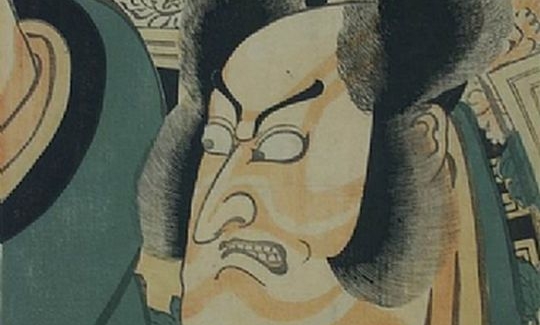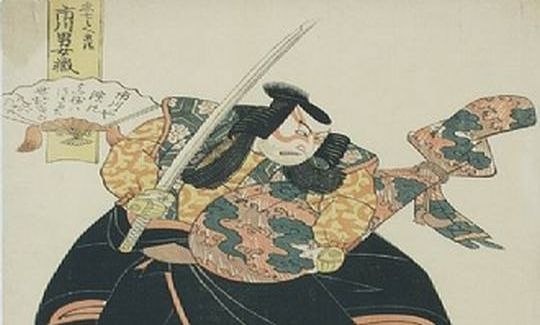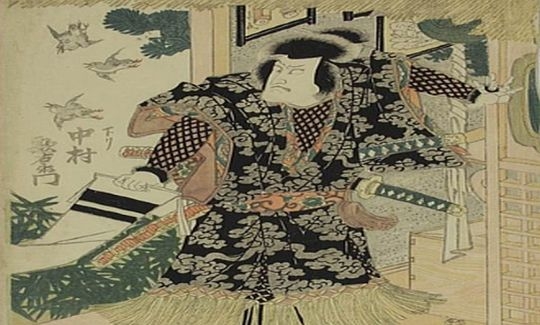The exhibition presents woodblock prints of the Yakusha-e (役者絵) genre - depictions of Kabuki (歌舞伎) actors by the most esteemed artists dealing with this subject. The word "Kabuki" is a combination of the Chinese characters for song, dance, and talent. The Kabuki Theatre developed at the end of the 16th century from performances by a woman named Okuni, who also played masculine roles and quickly became a focus of interest in the Pleasure Quarters of Japan. Ironically, only male actors appear in Kabuki performances today, and they also, where necessary, fill the female roles (onnagata). This is because, in 1629, the Shogun was attempting to neutralize the erotic aspects of the dramas and forbade women to appear on stage. In 1652 the Shogunate also forbade performances by youths, for the same reason.
Publicizing the Kabuki Theatre in the early 17th century required colourful announcements (banzuka-e) and posters (kaban-e) posted beside the theatres to inform audiences about the various performances, while increasing admiration for the actors by the audience was an important factor in the development of the yakusha-e genre. Three schools of artists specialized in depicting the Kabuki Theatre in woodblock prints, namely Torii, Katsukawa, and Utagawa. The artists of the Torii School began their careers as designers of announcements and posters for the theatre. Initially, their prints were monochromatic, and were often coloured by hand with a mixture of glue and powdered copper that created an impression of lacquer (urushi-e; lacquer pictures). At that time, the actor prints of the Torii School received the unflattering description - "Gourd-shaped legs and catfish outlines" (in Japanese: "hyoutan ashi, mimizu gaki"). In the earlier prints of the Torii artists, the actors were only recognizable from their names or the family crests appearing on their costumes, because emphasis was on the role rather than on the actor. In the mid-18th century, Torii Kiyomitsu (ca. 1735-1785) and other artists began to produce more attractive prints by adding red and green (beni-e) and other colours (benizuri-e). In general, prints by the Torii artists have strong outlines, their specific intention being to attract audiences to the theatre.
In the 18th century prints began to appear in a more realistic style in which it is possible to identify the actors at a glance. This is due to the development of the nishiki-e ("brocade pictures") technique, and of the acting mode known as "aragoto" (rough style).
The nishiki-e is a coloured woodblock print in which each colour is printed from a different block; and the aragoto style is characterized by exaggerated gestures, lavish costumes decorated with bold designs, and facial makeup (kumadori) consisting of broad stripes intended to convey the character of the role performed by the actor. For example, makeup consisting of red stripes conveys good character, whereas blue stripes signify a bad character. Such developments gave the artists greater freedom of expression and accuracy of detail, so that their works began to reflect the colourfulness of the life of pleasure.
The artists who paved the way for this new style were Shunsho (1726-1792), founder of the Katsukawa School, and Ippitsusai Buncho (worked 1765-1792). The two even worked together to produce an album called "Portraits of Actors on Fans" (Ehon butai ogi). Most of the prints of the Katsukawa School were made in "hoso-e" measurements (appr. 33 x 14 cm.). Usually, three hoso-e were carved side by side on a single woodblock and then separated, after printing on paper, into individual prints. In Shunsho's prints it was possible, for the first time, to recognize the actors by name, according to their features and other individual traits, rather than according to their roles, costumes, or the family crests on their clothing. Shunsho abandoned the formality of the Torii School's stylized, idealized depictions of the actors. He wanted to focus on the actors themselves. Although, like the Torii artists, he retained the flat, two-dimensional representation, his prints of actors' portraits paved the way for the realism that was characteristic of Japanese art during the last 25 years of the 18th century. Among Shunsho's most famous students were the artists Shunko, Shunei, Shunyo, and Shundo. Their prints were embodiments of the exaggerated gestures and fierce expressions of the actors at dramatic moments in the plays.
The demand for realism was conducive to the development of okubi-e (portrait pictures) that emphasized the facial expressions of the actors in close-up. The most outstanding artist of this genre was, without doubt, Toshusai Sharaku (worked 1794-1795). Sharaku depicted specific actors with individualized features, and did not beautify them as did other artists. The exaggerations evident in his works are viewed by his many admirers as satirizing the theatre, and this is apparently the reason that there was little demand for them. During the same period, prints depicting the world of the theatre also appeared, created by Torii Kiyonaga(1752-1815) and integrating actors, narrators, and musicians.
The artist Toyokuni I (1769-1825), who made the Utagawa School very famous, made spectacular use of the makeup and costumes of the actors in order to emphasize the effect of their expressions. The prints of Utagawa Kunisada (1786-1864), a brilliant disciple of Utagawa Toyokuni I, are characterized by their vibrant colours. He often depicted actors performing the "Mie", in which they move their feet, hands and head in broad gestures, widen and cross their eyes, and produce their voice in a particular register, "freezing" for several seconds in an impressive posture at the climax of a scene.
The Kabuki Theatre was, and remains, a spectacular experience for the audience because of the wealth of costumes, make-up and hairstyles, and the rich accessories. All this has provided subject matter for the print artists of the Edo period (1603-1868) - a colourful and inspirational world which they depicted at the highest level. In their woodblock prints, the actors' dynamic gestures and the vibrant colours appear in a form that is full of beauty and charm.



